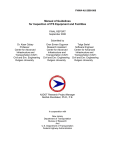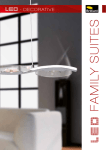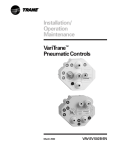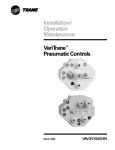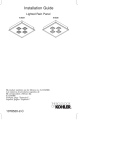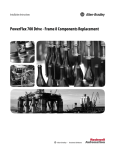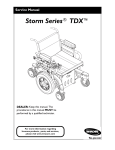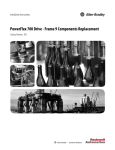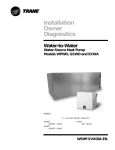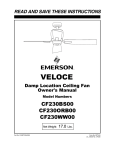Download Carrier 48HDT Unit installation
Transcript
TRANE R Installation Operation Diagnostics Belt Driven Blower Coil Air Handler BDH(V)B Models BDH/V B 048 BDH/V B 065 BDH/V B 080 BCXB-SVX02A-E4 TRANE ® Contents Performance Data 1 Model Nomenclature 2 General Specification 3 Unit Installation Unit Configuration 4-6 7 Dimension Data 8-11 Wiring Diagram 12 Operation / Start Up 13 Maintenance 14-16 Trouble Analysis 17-19 i TRANE ® Performance Data Foreword Installation General Information These instructions do not attempt to cover all variations in systems, nor to provide for every possible contingency to be met in connection with installation. Should further information be desired or should particular problems arise which are not sufficiently covered for the purchaser's purpose, the matter should be referred to the manufacturer. Warranty Warranty is based on the general terms and conditions of The Trane Company. The warranty is void if the equipment is repaired or modified without the written approval of the manufacturer, if the operating limits are exceeded or if the control system or the electrical wiring is modified. Damage due to misuse, lack of maintenance or failure to comply with the manufacturer's instructions or recommendations are not covered by the warranty obligation. This manual covers the installation, operation and maintenance of the Trane Chilled Water Blower coil Air Handlers. BDHB and BDVB completely designed to incorporate a single slab coil assembly, improved application flexibility, servicing and maintenance accessibility and an improved accessory line. BDH/VB are factory convertible type (vertical or horizontal) they are shipped in vertical position. Note: "Warnings" and "Cautions" appear at appropriate places in this manual. Your personal safety and the proper operation of this machine require that you follow them carefully. The manufacturer assumes no liability for installations or servicing performed by unqualified personnel. Reception Handling On arrival, inspect the unit before signing the delivery note. Specify any damage on the delivery note, and send a registered letter of protest to the last carrier of the goods within 72 hours of delivery. Notify the local Trane Sales Office at the same time. The unit will be supplied with a shipping based and protective packaging over the unit casing. The packaging should be kept on the unit during handling or storage on site. The unit should be totally inspected within 15 days of delivery. If any concealed damage is discovered, stop unpacking the shipment. Notify the carrier immediately by phone and registered mail. Notify the local Trane Sales Office. Concealed damage must be reported within 15 days of delivery. Check the unit nameplate to confirm that the proper unit was shipped. Available power supply must be compatible with electrical characteristics specified on component nameplates. 1 If it is necessary to remove the packaging for inspection prior to completion of on site handling, retain packaging parts and reapply them by tapping in position to prevent damage to the casing. The unit as supplied has a shipping base which is suitable for handling by a fork lift truck. TRANE BDH(V)B Model Nomenclature Digit 1,2 B D BLOWER COIL UNIT, BELT-DRIVEN, Cooling Only Digit 3 H Airflow Configuration H = Horizontal Discharge V = Vertical Discharge Digit 4 B Development Sequence, B = Second Digit 5,6,7 0 4 8 Nominal Capacity, Airflow [CFM] 048 = 4800 065 = 6500 Digit 8 G Installed Motor kW G = 2.2 H = 3.0 J = 4.0 K = 5.5 MODEL BDH/V B 048 BDH/V B 065 BDH/V B 080 080 = 8000 MOTOR SIZE OVERSIZE STANDARD J = 4.0kW G = 2.2kW K = 5.5kW H = 3.0kW K = 5.5kW J = 4.0kW FAN SIZE KAT 15s KAT 18s KAT 18s Digit 9 0 Electrical rating / Utilization Range : Volt / Phase / Hz. D = 380-415V / 3Ph / 50Hz K = 380V / 3Ph / 60Hz 3 = 230V / 3Ph / 60Hz 4 = 460V / 3Ph / 60Hz S = SPECIAL Digit 10 1 Chilled Water Coil 1 = 3 Row / RH Connection 2 = 3 Row / LH Connection 3 = 4 Row / RH Connection 4 = 4 Row / LH Connection Digit 11 0 Future Use Digit 12 A Factory Installed Option A = 1” Filter (Standard) B = 2” Washable Filter C = Discharge Plenum c/w Louver (Applicable on BDV - Series Only) D = 2” Washable Filter & Discharge Plenum c/w Louver Digit 13 0 Future Use Digit 14 A Minor Design Sequnce A = First Digit 15 A Service Indicator 2 ® TRANE ® General Specifications BDHB / BDVB Model Nom. Airflow CFM CMH Cooling Coil Coil Face Area 3 Row Total Capacity WFR WPD 4 Row Total Capacity WFR WPD Sq. ft (m2) Row/FPI MBH(kW) GPM (L/S) ft. wg (kPa) Row/FPI MBH(kW) GPM (L/S) ft. wg (kPa) Fins Material Header Material Tube Size (OD) in (mm) Header Diameter (OD) in (mm) Drain Connection Size in (mm) Fan Drive Type Fan Type Fan Size No. of Fans Motor kW / FanSpeed@**ESP 187 Pa kW / rpm (0.75”wg **ESP incl. 1” filter & 3 row Motor Type Power Supply Motor Size Standard / Hi Static Motor kW FLA(2) Std / Hi Static Amp (A) LRA(2) Std / Hi Static Amp (A) Filter Type Quantity - Size in Approx Operating Weight Unit Dimensions : H x W x L kg mm BDH(V)B 048 4800 8156 BDH(V)B 065 6500 11045 BDH(V)B 080 8000 13594 15.0 (1.39) 15.0 (1.39) 3 /12 231 (67.68) 161.3 (47.26) 261.9 (76.74) 46.03 (2.90) 32.14 (2.03) 52.18 (3.29) 22.36 (66.81) 16.21 (48.44) 27.84 (83.19) 4 / 12 279.0 (81.75) 197.2 (57.78) 320.5 (93.91) 55.59 (3.51) 39.30 (2.48) 63.87 (4.03) 43.61 (130.31) 30.75 (91.88) 55.46 (165.71) Aluminium Copper With Threaded Steel Connector (External) 3/8” (9.525) 1 1/4” (31.75) BSPT Threaded Connection 1 1/2” (38.10) BSPT Steel 10.22 (0.95) Belt Drive - Constant Speed Centrifugal Forward Curved Fan KAT 18-18 KAT 15-15 KAT 18-18 1 1 1 3.0 / 823 2.2 / 901 4.0 / 833 4 Poles - TEFC, IP55, Class F insulation 380-415V / 3ph / 50Hz 60Hz Motor - Special Option 3.0 / 5.5 2.2 / 4.0 4.0 / 5.5 6.78 / 11.7 5.16 / 8.80 8.80 / 11.7 48.14 / 81.9 35.09 / 56.32 56.32 / 81.9 1” Washable Filters 2-20” x 20” 2-20” x 25” 2-20” x 20” 1-20” x 25” 1-20” x 25” 320 270 320 1423 x 1438 x 702 1546 x 1755 x 772 1546 x 1755 x 772 Note: 1. Cooling Coil performances are rated at 26.7°C (80°F) EDB,19.4°C (67°F) EWB and nominal airflow listed (6.67°C EWT / 12.22°C LWT). 2. Motor current rated as per 380V / 3Ph / 50Hz. 3. Basic unit includes belt-drive fan motor, cooling coil and 1” washable filters. 4. Please refer to the product catalog for more details on unit dimension. 3 TRANE ® Unit Installation ! WARNING: OPEN AND LOCK UNIT DISCONNECT TO PREVENT INJURY OR DEATH FROM ELECTRIC SHOCK OR CONTACT WITH MOVING PARTS BEFORE ATTEMPTING ANY INSTALLATION OR MAINTENANCE The general location of the air handler is normally selected by the architect, contractor, and/or buyer. for proper installation, the following items must be considered. 1. Available power supply must agree with electrical data on component nameplate. 2. If external accessories are installed on the unit, additional clearances must be provided. 3. All ductwork should be properly insulated to prevent condensation and heat loss. Note: It is recommended that the outline drawings should be studied ! and dimensions properly noted and checked against selected installation site. Important: If adding external accessories to the unit, additional clearances must be considered for the overall space needed. This will prevent the straps from crushing the unit cabinet or damaging the unit finish. All units must be mounted level to assure proper drainage and operation. Unit Suspension - Typical Lifting Recommendations Before Preparing the unit for lifting, the center of gravity should be determined for lifting safety. Because of the placement of internal components, the unit weight may be unevenly distributed. The unit can be moved using a forklift of suitable capacity. For lifting the unit into an elevated mounting position, run lifting straps or slings under the unit and attached securely to the lifting device. Use spreader bars to protect the unit casing from damage. Test lifts the unit to determine proper balance and stability. Caution: Use spreader bars to prevent straps from damaging the unit. Install the bars between lifting straps, both underneath the unit and above the unit. WARNING: ON SITE LIFTING EQUIPMENT MUST BE CAPABLE OF LIFTING THE WEIGHT OF THE UNIT WITH AN ADEQUATE SAFETY FACTOR. THE USE OF UNDER-CAPACITY LIFTING DEVICES MAY RESULT IN PERSONAL INJURY OR DEATH AND CAUSE DAMAGE TO THE UNIT. Figure 1 4 If the unit will be suspended, use a suspension mouting kit to isolate the unit from structure. This is usually accomplished through the use of spring or rubber isolators, which are to be furnished by the installer. To install the suspension rods, check each of the following before mounting the unit. (a) Space Requirement And Clearances To allow adequate space for the unit and free air or service clearances. See figure 3. BDHB is applicable for horizontal application only. Typical Installation For BDHB Method 1 TRANE ® Unit Installation Suspend the unit using the factory provided mounting base or holes. This is usually accomplished through the use of spring or rubber isolators, which are to be furnished by the installer. Suitable hanging type vibration isolators (see figure 2 on page 9) may be used in conjunction with flexible duct connrctors to further limit vibration transmission on critical applications. Vertical Floor (BDVB only) For servicing and routine maintenance, provide access to the unit through removable panels in the ceiling. (b) Location, Mounting And Positioning Before installing any unit make sure proper preparation has been made at each unit location for piping and electrical connections. Check that the supporting structure is strong enough to support unit weights. Suspend the unit using the factoryprovided threaded mounting holes on top of the unit for BDHV or lifting lugs for BDH/V. See Dimensional Data Section for mounting holes or lifting lugs location. Caution: For BDVB, before hanging the unit on suspension rods, reinforce the cabinet around the knockouts, using a large washer inside the cabinet. Washers should be between the skin of the air handler and the nut on the suspension rod. Align the mounting holes of BDH/V with structure support and secure suspension rods to the structure, then to the air handler cabinet. If the mounting holes locations do not permit proper alignment with existing structure, it may be necessary to field fabricate cross members on existing structural beams. It is generally recommended that the unit be mounted on the sub - base so that adequate height can be provided for condensate drain trap. However, if adequate drainage can be provided, the unit may be mounted directly on the floor. It is recommended that either a polyurethane or thin rubber gasket be applied to the unit base to prevent paint damage and subsequent corrosion. Before installing any unit make sure proper preparation has been made at each unit location for piping and electrical connections. Allow adequate space for the unit and free air or service clearances. Refer to Dimension Data Section (for general unit dimension). All BDVB can be installed back to the wall. Service clearance required is 1m at both left and right hand sides of BDVB. 1m in front of the coil is minimum recommended airflow clearance. Vertical Sub - base (BDVB only) An accessory sub - base is available for vertical floor mount configuration, wihich will increase the height of the unit by 152 mm. It also allows for condensate drain trapping. 5 Water Pipe Connections The Water coils for the BDH/V series units have been designed with 3/8” (34.93 mm)OD copper tubes and W3BS aluminium fins. The copper headers are fitted with 43mm (1-1/4”) BSPT steel adapter for ease of connection. TRANE ® Unit Installation Warning: Care must be taken when connecting pipework to the coil headers. The header will not withstand the torque necessary for a watertight joint. Always support the coil connection with a suitable wrench when connecting pipework to the unit. Condensate protection for chilled water headers, valves and piping must be provided by installer. Condensate Connections Drain These air handlers come with standard drain pan. 38mm diameter drain connections are provided on the unit sides as required. U-Trap must be applied to avoid water being sucked back. See Figure 4 Auxiliary Drain Pan Filters Electrical connection Air handlers are shippen with 1" washable filters installed in the unit, 2"or 4" high efficiency secondary filter (BDVB) as an option. For filter dimensions, refer to General specification. Filters shall be accessible from the side coil access panel. All electrical lines, sizing, protection and grounding must be in accordance with the National Electric code and local codes. 1. If conduit is used, isolate whenever vibration transmission may cause a noise problem within the building structure. 2. Ensure all connections are tight and no wires exposed. 3. All accessories must be installed and wired according to the instructions packaged with that accessory. Duct Connections The supply and return ducts should be connected to the unit with flame retardant duct connectors and the use of flexible connectors field supplied is recommended for all duct connections in order to reduce vibration transmission. See figure 5. The retum duct should be sized to the same dimensions as the return inlet of the unit. A field fabricated auxiliary drain pan may be installed under the unit, and when condensate overflow may cause damage. This drain pan will eliminate any excess condensation that may be due to extreme humidity or an obstructed drain in the primary drain pan. Drain lines from this pan must be installed, but should not be connected to the primary drain line from the unit. Isolate the auxiliary drain pan from both the air handler and the structure. 6 ! WARNING: WHEN INSTALLING OR SERVICING THIS EQUIPMENT, ALWAYS EXERCISE BASIC POSSIBILITY OF ELECTRIC SHOCK THAT COULD RESULT IN SEVERE PERSONAL INJURY OR DEATH. TRANE ® Unit Configuration 7 TRANE Dimension Data 8 ® BDHB 48 - HDT TRANE ® Dimension Data 9 BDVB 48 - VDT TRANE Dimension Data 10 ® BDHB 65/80 - HDT TRANE ® Dimension Data 11 BDVB 65/80 - VDT TRANE BD - Series Wiring Diagram 12 ® TRANE ® Operation / Start-Up Pre-Start-Up Inspection Start-Up procedures Perform the following checks and inspections before operating the unit. After completing all items under "PreStart-Up", the unit may be started and the following checks and adjustments performed: Inspection Checklist a)Unit is mounted securely to the ceiling support rods (mounting units). b)Ductwork connections are complete, valve and piping have thoroughly insulates. c)Coil connections are complete and tight. d)Condensate drain pan connections are complete and tight. e)Electrical connections completed. Wiring is correct and in accordance with the wiring diagram. Ground connection completed. f)Check and retighten, if necessary all the motor, fan pulley, fan bearings and wheel. g)Rotate fan by hand, to ensure that is runs freely and that there is no interference. h)Check and retighten, if necessary, drive and bearing bolts, motor clamp plate bolts and isolator bolt. i)Check to ensure that pulley is correctly aligned and that shaft is parallel. j)Check belt tension as per instruction given in the maintenance section. 13 a)Measure the motor voltage and amps on all phases to insure proper operation. Compare these reading with the motor nameplate. b)Disconnect load and start motor to check the direction of rotation. If the rotation need to be changed, stop the motor completely and change the direction of rotation by changing the line connection. c)After connecting the load, the motor should start quickly and run smoothly. If it does not, the power supply should be switched off at once and all connections, as well as the power supply, should be rechecked before re-starting. d)In the event of excessive vibration or unusual noises, the motor should be disconnected from the load and checked for poor alignment, loose mounting bolts, etc. e)When the motor has been operated under load for a short period of time, check that the operating current with the nameplate current. TRANE ® Maintenance ! WARNING: WHEN INSTALLING OR SERVICING THIS EQUIPMENT, ALWAYS EXERCISE BASIC SAFETY PRECAUTIONS TO AVOID THE POSSIBILITY OF ELECTRIC SHOCK THAT COULD RESULT IN SEVERE PERSONAL INJURY OR DEATH. Monthly Inspection 1Check condition of air filters and replace them if necessary. 2.Check the drain pan to be sure that it is clean and free to carry the flow of condensate through the drain line. 3.Check the coil surface for cleanliness. Clean if necessary. Yearly Inspection 1.Replace filters. 2.Check coil surface, clean by vacuuming or flushing with cold water. Do not use steam or hot water. 3.Carry out check (g) through (j) as detailed in inspection chelist in the Operation Section. 4.Inspect the condition of the fan belt and replace if necessary. The belts fitted to units cannot achive design performance without the correct tensioning.See figure 6. 5.Check condition of vibration isolators, replace if there is any sign of wear, loosening or material deterioration. 6.Check fan bearings for noisy operation and excessive lubricant leakage. Replace if necessary. 7.Inspect the condensate drain pan and condensate piping to make sure they are clear and will carry away all water. 8.Inspect the control panel wiring to make sure connections are tight and insulation is intact. 9.Check system for water leaks. 14 Change / Clean Filters Change or clean air filters at least twice a year. Filters will require more frequent care under high load conditions or dirty air. A clogged air filters reduces airflow, cooling capacity and increases energy usage. To clean washable filters, remove the filter media and wash it in water to remove dust, dirt and lint; allow to dry thoroughly before re-installing in the units. Do not rub or wring. Washable filters can also be cleaned by blowing with compressed air in opposite direction of filter airflow. High efficiency secondary filter can't be washed and must be replaced when it is dirty. TRANE ® Maintenance It is important that belts are maintained at the correct tension to avoid premature bearing failure and unnecessary belt wear. There are two methods of checking belt tension. a)The increase in belt length when it is stretched can be measured. The increase under tension should be from 0.6% for a small unit with continuous running, to 1.0% for large units with irregular motor torque. b)Using a proprietary instrument such as the browning belt tension checker. Belt Maintenance Clean fan belts and pulleys with a dry cloth. Oil and grease must be kept off belts. The use of a belt dressing is not recommended. Where replacing belts, use a matched set. Do not force belts onto pulleys, but adjust motor position to allow mounting and then re-tighten. Sheave Alignment When the sheaves are aligned, the straightedge will touch both sheaves at points A throught D. A string, drawin tight may be used in the same manner. For uneven width sheaves, place a string in the center groove of both sheaves and pull tight. Adjust sheaves and tighten the sheave set screws to the proper torques, given in Table 2. To prevent interference of the fan frame with the belt, make sure that the belt edge closest to the motor has the proper clearance from the fan frame, as shown in Figure 7. Align the fan and motor sheaves by using a straightedge as shown in Figure 8. The straightedge must be long enough to span the distance between the outside edges of the sheaves. Table 2 Recommended Torques for Tightening Sheaves and Bearing Thrust Collar Torque for Tightening Sheave Setcrews Torque for Tightening Bearing Thrust Collar Torque for Tightening Fan Wheel Setscrews Inch Lbs. Foot Lbs. N-m Inch Lbs. Foot Lbs. N-m Inch Lbs. Foot Lbs. N-m 144 12 16.3 66 5.5 7.5 144 12 16.3 Pulley Alignment This is checked by means of a straight edge, which should touch both edges of both pulleys at the same time. 15 TRANE ® Maintenance Maintenance Training Contract It is strongly recommended that you sign a maintenance contract with your local Service Agency. This contract provides regular maintenance of your installation by a specialist in our equipment. Regular maintenance ensures that any malfunction is detected and corrected in good time and minimizes the possibility that serious damage will occur. Finally, regular maintenance ensures the maximum operating life of your equipment. We would remind you that failure to respect these installation and maintenance instructions might result in immediate cancellation of the warranty. 16 The equipment described in this manual is the result of many years of research and continuous development. To assist you in obtaining the best use of it, and maintaining it in perfect operating condition over a long period of time, the constructor have at your sisposal a refrigeration and air conditioning service school. The principal aim of this is to give operators and maintenance technicians a better knowledge of the equipment they are using, or that is under their charge. Emphasis is particularly given to the importance of periodic checks on the unit operating parameters as well as on preventative maintenance, which reduces the cost of owning the unit by avoiding serious and costly breakdown. TRANE ® Trouble Analysis Use the tables in this section to assist in identifying the cause of causes of a malfunction in BD Series operation. The column header RECOMMENDED ACTION will suggest repair procedures. Note: These Tables are intended as a diagnostic aid only. For detailed repair procedures, contact your local Trane Service Company. Warning: Disconnect electrical power source and allow all rotating equipment to stop completely before 17 inspecting or servicing the unit. Failure to do so may result in personal injury or death from electrical shock or moving parts. Warning: Disconnect electrical power prior to access into a fan ductwork. Even when locked out electrically, fans may cause injury or damage if the impeller is subject to "windmilling". The impeller should be secured to physically restrict rotational movement. Failure To secure impeller can cause severe personal injury or death. TRANE ® BD Series Trouble Analysis Symptom Probable cause Recommended Action Bearing is excessively hot First Start After relubrication. (grease Allow mechine to cool down and restart. distribution) Over-lubrication, Clean Surface of grease and purge. Over tensioned belts. Tension belts. No lubricant. Apply lubricant. Check bearings for damage. Motor falls to start Misaligned bearing. Correct alignment. Check shaft level. Blown fuse or open circuit breaker. Replace fuse or reset circuit breaker. Overload trip. Check and reset overload. Inproper wiring or connections. Check wiring with diagram supplied on unit. Improper current supply. Compare actual supply power with motor nameplate recommendations. Contact power company for adjustments. Mechanical failure. Check that motor and driave rotate freely. Check bearing lubricant. Motor stalls Open phase. Check line for an open phase. Overloaded motor. Reduce load or replace with larger motor. Low line voltage. Check across AC line. Correct voltage if possible Excessive vibration Poor alignment. Align bearing set screws. Loosen and retighten bearing set screws. Shipping spacers not removed. Remove shipping spacers and/ or bolts. Motor runs and then dies down Over tensioned belts Adjust belts tension. Misaligned drive Align drive. Partial loss of line voltage. Check for loose connections. Determine adequacy of main power supply. Motor does not come up to speed. Stator shorts when motor warms up. Replace stator. Low voltage at motor terminals. Check across AC line and correct voltage loss if possible. Motor overheats Line wiring to motor too small. Replace with larger sized wiring. Overloaded motor. Reduce load or replace with a larger motor. Motor fan is clogged with dirt Remove fan cover, clean fan and re- preventing proper ventilation. place cover. 18 TRANE ® BD Series Trouble Analysis Symptom Probable cause Recommended Action Excessive motor noise. Motor mounting bolts loose. Tighten motor mouting bolts. Rigid coupling connections. Replace with flexible connections. Worn motor bearings. Replace bearing and seals. Fan rubbing on fan cover. Remove interference in motor fan housing. Rapid motor bearing wear Excessive overhung load due to Check belt tension and overhung load. overtensioned drive. Excessive overhung load due to a Replace sheave with larger one. small diameter motor sheave. Loose fan belt Motor is poorly positioned. Adjust belt tension. Worn or damaged belt. Replace belt or belt set. Check sheave alignment. Short belt Life Worn sheaves. Replace sheaves. Worn sheaves. Replace sheaves. Misaligned belt. Realign drive with MVP sheave set at mean pitch diameter. Grease or oil on belts. Check for leaky bearings. Clean belts and sheaves. Belt slipping. Adjust tension. Belts rubbing. Remove obstruction or realign drive for clearance. Bearing Noise Poor alignment. Loosen bearing set screws and realign. Inadequate lubrication. Grease bearing(s). Low coil capacity Air is bypassing coil. Prevent bypass with blockoffs. (Chilled Water) Coil tubes are blocked. Clean and unblock tubes. Incorrect airflow. Check fan-operating conditions. Incorrect gpm. Check water pumps, valves and lines for obstructions. Under CFM or low air flow Incorrect water temperature. Provide proper water temperature. Belt loose Adjust belt tension or clean belt if it is greasy. Duct leakages Check duct joining or turning. Duct obstruction or too small Increase fan rpm to overcome high causing high static static but fan and motor working limitations must be considered. Over cfm or high air flow Water leaking Dirty filter or coil Change filter and clean coil. Low static due to oversize duct or duct Replace pulley to reduce fan rpm to work too short meet requirement. Drain pipe choked Clear drain pipe. Improper or no U-trap Ensure U-trap installed properly. Water carry over due to high velocity Replace pulley to reduce fan rpm. 19 TRANE ® Literature Order Number BCXB-SVX02A-E4 (April 2007) File Number Trane A business of American Standard Companies www.trane.com For more information, contact your local district office Supersedes BCXB-SVX02A (October 2006) Stocking Location Malaysia Trane has a policy of continuous product and product data improvement and reserves the right to charge design and specifications without notice. Only qualified technicians should perform the installation and servicing of equipment referred to in this publication.






















